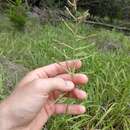Comments
provided by eFloras
This is the only species of
Paspalum in China lacking both glumes.
The species is cultivated for hay and sometimes used in soil conservation work.
- license
- cc-by-nc-sa-3.0
- copyright
- Missouri Botanical Garden, 4344 Shaw Boulevard, St. Louis, MO, 63110 USA
Description
provided by eFloras
Perennial with short rhizomes. Culms slender to robust, 1–2 m tall. Leaf sheaths papillose-pilose in upper part and mouth; leaf blades linear-lanceolate, flat, 10–40 × 0.6–3 cm, glabrous or pilose, the lower narrowed to a slender base, apex long acuminate; ligule ca. 2 mm. Inflorescence axis 4–20 cm; racemes up to 30, 3–6 cm, ascending, axils long pilose; spikelets paired, in 4 dense rows; rachis winged, 0.5–1.5 mm wide, margins scabrous, sometimes setose. Spikelets often purplish, oblong-navicular, 1.5–2.5 mm, glabrous; both glumes absent; lower lemma as long as spikelet, concave, membranous, 3-veined with laterals marginal; upper lemma dorsally convex, papery, 5-veined, veins prominent and forming ribs, apex acute. Fl. and fr. summer–autumn. 2n = 20, 40.
- license
- cc-by-nc-sa-3.0
- copyright
- Missouri Botanical Garden, 4344 Shaw Boulevard, St. Louis, MO, 63110 USA
Habitat & Distribution
provided by eFloras
Cultivated. Gansu [native to South America].
- license
- cc-by-nc-sa-3.0
- copyright
- Missouri Botanical Garden, 4344 Shaw Boulevard, St. Louis, MO, 63110 USA
Comprehensive Description
provided by North American Flora
Paspalum elongatum Griseb. Abh. Ges. Wiss. Gott. 19 : 260. 1874
Stems up to 1 m. tall or more; leaves pubescent or glabrous; blades 1-2 dm. long, 6-15 mm. wide; panicle 1-2 dm. long, of 10-15 spreading or ascending racemes, the rachis with scattered hairs; spikelets in pairs, 2-2.5 mm. long, elliptic, obtuse, the first and second scales wanting, the third scale herbaceous, glabrous, 3-nerved, the fruiting scale prominently 5-ridged, p ap illose-str iat e .
Type locality : In valleys near Ascochinga, Cordoba, Argentina. Distribution : Yucatan; also in South America.
- bibliographic citation
- George Valentine Nash. 1912. (POALES); POACEAE (pars). North American flora. vol 17(2). New York Botanical Garden, New York, NY
Physical Description
provided by USDA PLANTS text
Perennials, Terrestrial, not aquatic, Rhizomes present, Rhizome short and compact, stems close, Stems nodes swollen or brittle, Stems erect or ascending, Stems caespitose, tufted, or clustered, Stems terete, round in cross section, or polygonal, Stem nodes bearded or hairy, Stem internodes solid or spongy, Stem internodes hollow, Stems with inflorescence less than 1 m tall, Stems with inflorescence 1-2 m tall, Stems, culms, or scapes exceeding basal leaves, Leaves mostly cauline, Leaves conspicuously 2-ranked, distichous, Leaves sheathing at base, Leaf sheath mo stly open, or loose, Leaf sheath hairy, hispid or prickly, Leaf sheath and blade differentiated, Leaf blades linear, Leaf blades 2-10 mm wide, Leaf blades 1-2 cm wide, Leaf blades 2 or more cm wide, Leaf blades mostly flat, Leaf blade margins folded, involute, or conduplicate, Leaf blades mostly glabrous, Leaf blades more or less hairy, Ligule present, Ligule an unfringed eciliate membrane, Inflorescence terminal, Inflorescence solitary, with 1 spike, fascicle, glomerule, head, or cluster per stem or culm, Inflorescence a panicle with narrowly racemose or spicate branches, Inflorescence branches more than 10 to numerous, Inflorescence branches 1-sided, Rachis dilated, flat, central axis to which spikelets are attached, Rachis winged, Rachis angular, Flowers bisexual, Spikelets pedicellate, Spikelets dorsally compressed or terete, Spikelet less than 3 mm wide, Spikelets with 1 fertile floret, Spikelets with 2 florets, Spikelet with 1 fertile floret and 1-2 sterile florets, Sp ikelets paired at rachis nodes, Spikelets all alike and fertille, Spikelets bisexual, Spikelets disarticulating below the glumes, Spikelets secund, in rows on one side of rachis, Rachilla or pedicel glabrous, Glumes completely absent or reduced to cuplike structure, Glume equal to or longer than spikelet, Lemma becoming indurate, enclosing palea and caryopsis, Lemma 3 nerved, Lemma 5-7 nerved, Lemma glabrous, Lemma apex truncate, rounded, or obtuse, Lemma awnless, Lemma saccate or swollen, Lemma straight, Palea present, well developed, Palea shorter than lemma, Stamens 3, Styles 2-fid, deeply 2-branched, Stigmas 2, Fruit - caryopsis, Caryopsis white.

